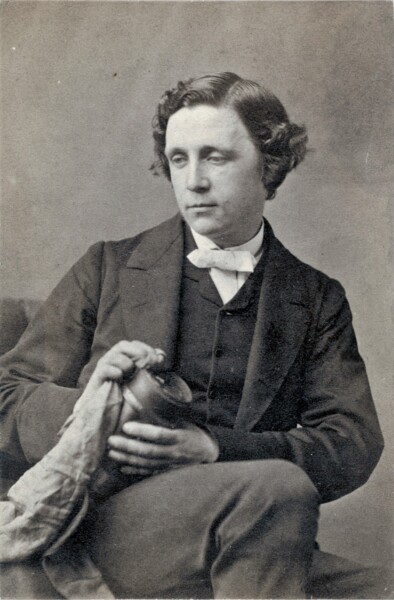“Alice’s Adventures in Wonderland” and “Through the Looking-Glass, and What Alice Found There”
by Lewis Carroll

Lewis Carroll (1863)
Reviewed by Ed Lengel
In the summer of 1862, at the height of Great Britain’s Victorian era, the Reverend Charles Lutwidge Dodgson, a lecturer in mathematics at Christ Church, Oxford, took the three young daughters of his dean on a rowing excursion, with a stop on shore to have tea. Among the children was ten-year-old Alice Liddell, a precocious girl who pressed the thirty-year-old Dodgson to continue spinning a fantasy yarn he had been telling her in installments and would continue to do in the days ahead. Dodgson obliged. Indeed, he was powerless to resist. And so was born a tale originally titled, “Alice’s Adventures Underground,” and finally published in 1865 as Alice’s Adventures in Wonderland, under the pen name of Lewis Carroll. The continuation, Through the Looking Glass, would appear six years later, and now the two stories are typically bound together.
The tales of Alice’s adventures, with their remarkable characters—the Mad Hatter, the Cheshire Cat, the Queen of Hearts, and—Alice—have had an enormous impact on English language literature and culture. Yet a huge conceptual gulf exists between the time of their creation and today, especially in the completely transformed relationship between children and adults. Dodgson’s very act of taking three children, not his own, on an unsupervised day-long excursion is well-nigh unfathomable one hundred and sixty years later. And rare would be the adult willing to engage in Dodgson’s unbridled storytelling, without nervous glances toward the children’s parents, inevitably hovering nearby. Nor, on the other hand, would the Victorians have been able to comprehend the willingness of twenty-first century parents to allow their children to roam, unchaperoned, the far more predatory world of the Internet via their smartphones.
The stereotype of Victorians being cruel and oppressive toward children, which originated—in part—because of the work of another Victorian author, Charles Dickens, is dominant today. Yet it is also profoundly inaccurate. The Victorian conception of childhood was in fact subtle and reverential, and far from the “spare the rod and spoil the child” attitude that was far more common in the eighteenth and twentieth centuries. Dodgson, as Lewis Carroll, summed up his attitude, shared by many if not most of his contemporaries, in a later appraisal of his work: “The why of this book cannot, and need not, be put into words. Those for whom a child’s mind is a sealed book, and who see no divinity in a child’s smile would read such words in vain; while for anyone who has ever loved one true child, no words are needed. For he will have known the awe that falls on one in the presence of a spirit fresh from God’s hands, on whom no shadow of sin, and but the outermost fringe of the shadow of sorrow, has yet fallen.”
Much of children’s literature of the day—most notably, that of fairy-tale writer George MacDonald, who convinced Dodgson to turn his tales of Alice into a book—reflected this awestruck attitude toward childhood, and its embodiment of qualities that adults had lost. Children’s storytellers spoke, or wrote, as an act of service to children; much as Dodgson told of the imaginary Alice’s adventures in response to prodding by the real Alice at the lakeshore picnic. Over time, sadly, much of the original magic has been lost; in the same way that other children’s classics, like L. Frank Baum’s The Wizard of Oz, and J.R.R. Tolkien’s The Hobbit, have lost their true essence to modern hands.
Film adaptations, and modern re-illustrated republications, of the original Alice stories have, at best, reduced Dodgson’s wildly imaginative, even phantasmagoric, imagery to mere nonsense. Not a shadow of the original Victorian illustrator John Tenniel’s brilliance, for example, is evident in the soulless Disney adaptations. More disturbingly, modern interpretations such as Tim Burton’s 2010 movie—memorably described by critic Roger Ebert as an “adult hallucination”—have plundered Dodgson’s ideas for their allegedly darker elements; and the morbid modern obsession with Dodgson’s supposed (and, be it said, utterly unproven) sexual depravity; reflect more of modern-day attitudes than Victorian realities.
The key to understanding Alice in Wonderland and Through the Looking-Glass is in Dodgson/Carroll’s use of the word “awe.” Childhood was to him, MacDonald, and other contemporaries, something sacred; a place, toward which adults could not but kneel in reverence. The storyteller’s act of service was analogous to building a ladder to aid the child in exploring on his or her own. Alice’s adventures, as told by Dodgson, were intended as a beginning, not an end; a mere hint of what would unfold in the real Alice’s mind. Another adult responsibility followed upon this: protecting the child’s imaginative space from interruption, or corruption. Modern attitudes, and particularly the overwhelming politicization of children’s literature in our own day, could not be more different. Now, with the sacred imaginative boundary between child and adult all but obliterated, it makes sense that children should be subjected to the dominance of adult political obsessions or be abandoned to commercial (or other) exploitation on the Internet. Lewis Carroll’s deference, or reverence, toward children, in his own storytelling offers an old, and new direction.
Ed Lengel is an author, a speaker, and a storyteller.




